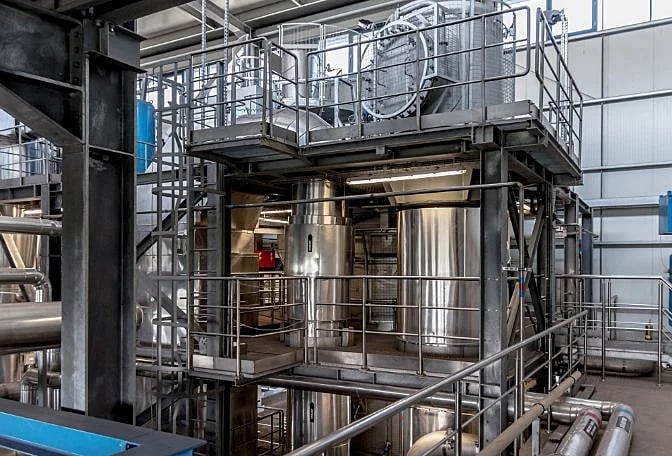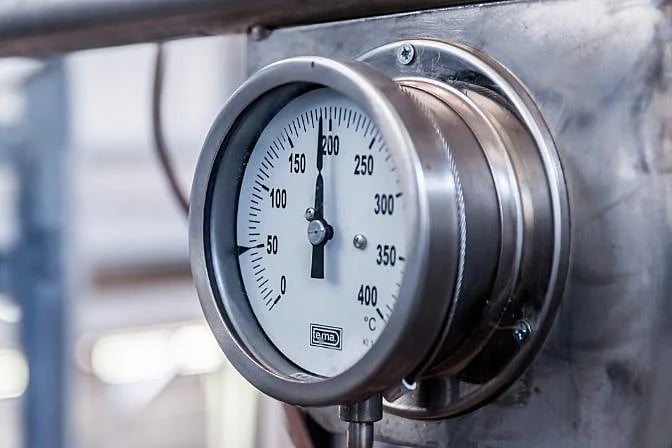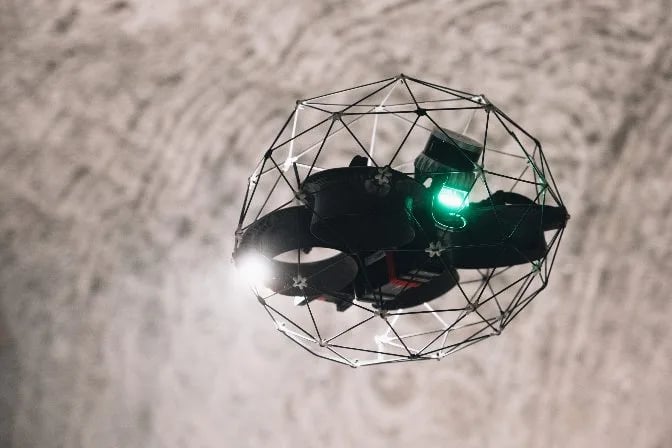Boiler inspections are crucial for any industry that uses industrial boilers
Boilers operate under extreme pressure and extreme fluctuations in temperature, often undergoing swings in temperature of hundreds of degrees Fahrenheit.

Without periodic inspections a flaw in a boiler could go undetected.
Over time, that small, undetected problem will worsen, and could, in the worse case, lead to a catastrophic failure that could cause an explosion, injuring or even killing those working nearby.
Boiler inspections help prevent catastrophic failures by uncovering and tracking flaws so that proper maintenance procedures can be followed.
This guide to boiler inspections covers the basics of what a boiler is and does, what happens during a boiler inspection, the work that an inspector of boilers does, and how industries that use boilers can benefit from employing a drone for their inspections.
Here is a list of the topics we cover in this article to help you find the information you’re looking for:
- Boiler Inspection Basics—What Boilers Are, What They Do, and the Industries that Use Them
- What Is Inspected in a Boiler Inspection
- Five Benefits to Using Drones for Boiler Inspections
Boiler Inspection Basics—What Boilers Are, What They Do, and the Industries that Use Them
Before we take a closer look at how boiler inspections are conducted, let’s start at the beginning and answer some basic questions about boilers.
WHAT IS A BOILER?
A boiler is a closed vessel whose purpose is the creation of hot water or steam. This steam is then used as a power source for various purposes (see the next section for some examples).
Typically, in order to create steam in a boiler, coal, oil or gas is converted into heat by combustion. That heat is then applied to the water contained in the boiler and, as the water is heated, it turns into steam.
WHAT IS THE PURPOSE OF A BOILER?
The steam produced by a large boiler is used as an energy source for various types of needs, including:
- Power generation. Steam can be used to power components within various facilities, such as pumps, blowers, or turbines for generating electricity.
- Production. Steam-driven power can help a company in making a product by providing power, the extreme heat needed for production, or sterilization.
- Climate control. Steam can also be used to power a.c. and heating units, either to maintain the temperature needed for equipment or to create a comfortable working environment for employees.
Steam boiler inspectors work to make sure boilers stay in good condition, helping identify potential flaws before they become worse.
HOW DOES AN INDUSTRIAL BOILER WORK?
Boilers are designed to transfer the maximum amount of heat from combustion into the water in the boiler using conduction, convection, and radiation.
The more efficient this process is, the greater the savings will be for the company.
But boilers don’t simply heat water in order to produce steam. Conditions within a boiler are also optimized to increase the boiling point of water through pressurization. This works the same way in a pressure cooker, where an airtight seal speeds up the time it takes to boil water, or to cook in general.
So how does an industrial boiler work?
Through the combination of pressure, an efficient fuel source, and an efficient mechanism for transferring heat to the water, boilers are able to create huge amount of energy in the form of steam.
Boilers use various kinds of fuel to create heat, and thereby generate steam:
- Coal. This is a common fuel source for boilers
- Gas. Gas refers to either propane or natural gas
- Oil. Oil refers to either gasoline or petroleum-based fluids
- Wood chips or pellets. Only biomass boilers can use wood pellets for fuel.
WHAT DIFFERENT KINDS OF BOILERS ARE THERE?
There are many different types of boilers out there. The difference between them has to do with the way heat is conveyed to or through the water in order to turn it into steam.
Here are some of the most common types of boilers:
- Fire-Tube Boiler. In a fire-tube boiler, fuel is burned inside the furnace and then the heat produced is transferred by tubes through the water in the tank to generate steam. Fire-tube boilers are one of the cheapest types of boilers to create since their design and construction is fairly straightforward. For the same reason, they are typically limited to low and medium pressure applications because their shell is not thick enough for higher pressures.
- Recovery Boiler. Recovery boilers are used in the pulp and paper industry. They burn black liquor (a pulping byproduct) and recover inorganic elements in order to generate superheated steam.
- Water-Tube Boilers. Water-tube boilers are similar to fire-tube boilers, but in water-tube boilers water tubes are heated inside the furnace to create steam instead of heating fire tubes that then transfer heat to the water inside of a tank. Water-tube boilers are more efficient than fire-tube boilers, but also more complex and therefore more expensive.
- Biomass Boiler. Biomass boilers are similar to gas-fueled boilers except that they use bio fuel, such as wood chips, wood pellets, logs, or other forms of biomass to create heat instead of using fossil fuels.
WHICH INDUSTRIES USE BOILERS?
Some of the biggest industries that use boilers in their work are Oil & Gas, Power Generation, Chemicals, and Steel.
But boilers are important in the everyday operations of several other industries. Here are some of them:
- Alcohol distilleries
- Cement
- Fertilizer
- Paint
- Pharmaceuticals
- Plywood
- Pulp and Paper
- Rubber
- Sugar
- Textile
What Is Inspected in a Boiler Inspection?
Because boilers are subjected to extreme fluctuations in temperature and extreme pressure they have to be incredibly strong.
Industrial boilers are often made by welding together thick steel plates, which can generally withstand the high pressures exerted against them.
But these plates can crack and buckle over time, which is why proper maintenance procedures are so important. If a problem goes undetected for too long, the boiler could suddenly explode with a force equivalent to a bomb going off.
This is why safety is the primary concern for steam boiler inspectors conducting boiler inspections.
Another concern is preserving the longevity of the boiler. Even if a disaster is not imminent, allowing a flaw to persist without maintenance could lead to a shorter lifespan for the asset, which will lead to increased costs for the company.
HOW OFTEN ARE BOILER INSPECTIONS CONDUCTED?
Most laws and insurance company guidelines recommend an annual inspection of large boilers. This inspection would be a thorough internal and external inspection, with the boiler cool and under no pressure.

However, some organizations recommend conducting an additional external inspection halfway through the year while the boiler is under pressure.
Studies have shown that increasing the frequency of boiler inspections can lead to an increase in the asset life and a reduction in the release of greenhouse gases, but companies have to weigh these benefits against the cost of doing more inspections.
WHO CONDUCTS BOILER INSPECTIONS?
Boiler inspections are done by trained and certified technical specialists who are experts in the inspection of boilers. Given the high degree of specialization required for boiler inspections, companies usually contract out this type of work instead of using someone in-house.
[Related read: Insourcing vs. Outsourcing Your Industrial Inspection Drone Program]
REGULATORY REQUIREMENTS FOR BOILER INSPECTIONS
Because boilers can be extremely dangerous if not properly maintained, the processes for inspecting them are rigorous and required by law in most countries.
The American Society of Mechanical Engineers (ASME) has created standards and codes for the installation of boilers, and the American Petroleum Institute (API) has created standards for boiler inspections, both of which are followed all over the world.
One aspect of these requirements is that inspections must be conducted by certified steam boiler inspectors, usually in the presence of a representative from a formal inspection body.
[Related read: Can a Drone Be Used as a Formal Inspection Tool?]
Formal inspection bodies are independent companies that have been approved by standards organizations, like API or ASME, to sign off on whether an inspection has been conducted in compliance with the relevant regulations.
For example, in order for a company to conduct an API 510 inspection they must use an inspector who is certified by API for an API 510 inspection and also must employ a representative from a formal inspection body to verify that the inspection was conducted within the requirements of the API’s standards.
Want to learn more about standards for boiler inspections? Here are overviews of two of the most relevant standards from API:
- API RP 573—Inspection of Fired Boilers and Heaters
- API 510—Pressure Vessel Inspection Code
WHAT IS INSPECTED IN A BOILER INSPECTION?
When inspecting a boiler, inspectors have a specific list of items that need to be reviewed visually both inside and outside.
The goal for both the external and the internal inspection is to conduct a visual review of each part of the boiler in order to identify potential problems that could require maintenance.
While external inspections are straightforward and do not require any special preparation beyond making sure the boiler is cool and depressurized, internal boiler inspections can be difficult because of limitations with accessing various parts of a boiler.
In a manual internal boiler inspection, an inspector must physically enter the boiler, which requires the company to build scaffolding for the inspector to stand on during the inspection. Once the inspection is complete, the scaffolding must then be taken down after the inspection.
The requirement for scaffolding can extend the downtime needed for the inspection by several days, and can often cost thousands to tens of thousands of dollars for the construction and removal of scaffolding.
EXTERNAL BOILER INSPECTION ITEMS
- Boiler room condition. As part of a boiler inspection inspectors will usually inspect the room in which the boiler sits to make sure there is no flammable debris or other encumbrances that could present a safety hazard.
- Nameplate. Inspectors will often begin their work at the nameplate, where they can find out the boiler type, when the boiler was made, the maximum pressure allowable in the boiler, and the types of controls needed for the boiler according to ASME manufacturing code and NBIC (National Board Inspection Code) requirements.
- Safety valve. From a safety perspective, the safety valve is arguably the most important part of a boiler and will be an important device to review during a boiler inspection. If a problem develops in the boiler, the safety valve (also called the Relief Valve) will help prevent over-pressurization, which can lead to an explosion.
- Control safety devices. Also of high importance for safety are control safety devices. Examples include the fuel train, the emergency shut off switch, and operating switch. All of these devices must be visually examined during a typical boiler inspection to ensure continued safe use of the boiler.
- Piping. Boiler room piping is used to move water and fuel in and out of the boiler. The condition of the piping must be reviewed during any boiler inspection, both to ensure that it is still in good condition and also to ensure that it is the right kind of piping for the ways it’s being used according to ASME standards. Flue pipe connections must also be inspected to ensure that carbon monoxide is being expelled properly, and not building up in the boiler room.
- Fresh air for combustion. Burners within a boiler must receive the correct ratio of fuel to air, which is why inspectors will review the combustion air requirements of the boiler during an inspection to make sure the air pathway is open and providing enough fresh air for the boiler to work properly.
INTERNAL BOILER INSPECTION ITEMS
- Walls and surfaces. All internal walls and surfaces are inspected, looking for any signs of leaks, corrosion, overheating, or other structural issues within the boiler.
- Waterside areas. All waterside areas of the boiler are inspected, including blow-off, water connections, and steam areas.
- Fireside conditions. All fireside conditions are inspected inside the boiler, including superheaters, deaerators, and economizers.
Five Benefits to Using Drones for Boiler Inspections
Using a drone instead of a person for collecting visual data in a boiler inspection has several benefits, the biggest of which are safety and savings.
But you can’t use just any drone for a boiler inspection.
Boilers present many challenges for flying, since the space within them is tight and full of objects for a drone’s blades to hit, which would immediately bring a normal drone crashing down.
Also, in order to collect useful visual data, the drone must be stabilized while in flight and have a light source that can allow inspectors to understand the depth of different items on a wall or ceiling that’s being inspected, such as pitting, grooves, or welds.
Flyability drones are designed specifically for inspections inside confined spaces like boilers, and help address all of these challenges. Flyability’s Elios 1, Elios 2, and Elios 3 all sit within a cage, which allows the drone to collide and continue flying, making them uniquely suited for boiler inspections.

Elios 3 conducting a visual inspection flight
Here is a list of all five ways that companies benefit by using a drone for boiler inspections instead of a person:
1. SAFETY
Sending a drone into a confined space instead of an inspector keeps people out of potentially dangerous scenarios, improving the overall safety for those involved in the boiler inspection process.
2. SAVINGS
Using a drone instead of a person to collect visual data inside a boiler can significantly reduce the cost of the inspection, in some cases by as much as 90% or more.
These savings are primarily realized in not having to build and take down scaffolding, as well as in the improved turnaround time for the boiler resulting from not having to wait for scaffolding to be constructed and taken down.
3. ACCESS
Using a drone made just for indoor inspections, such as the Elios 3, inspectors can get a close view of burners, tubes, and other parts of the boiler that are typically hard to access during a manual inspection.
4. BETTER DATA
Using a drone can often mean gathering higher quality visual data than might be gathered manually, which can allow for the identification of specific burners and openings that need closer inspection and possibly maintenance. The Elios 3 is equipped with a LiDAR sensor that creates 3D maps in real time.
5. REDUCING GREENHOUSE GAS EMISSIONS
Decreasing the cost of boiler inspections by using a drone can allow companies to increase the frequency of inspections. A study conducted by Boiler Room Consulting found that an increase in the frequency of inspections supported by Flyability drones could potentially reduce CO2 emissions by as much as 649 metric tons a year.
-
Electric Steam Boiler Manufacturers: Efficient Industrial SolutionsNewsAug.15,2025
-
Leading Electric Steam Boiler Manufacturers for IndustryNewsAug.14,2025
-
Buy Waste Heat Boilers: Custom, Efficient & Affordable SolutionsNewsAug.13,2025
-
Electric Steam Boiler Manufacturers | Industrial Power & EfficiencyNewsAug.12,2025
-
Electric Steam Boiler Manufacturers: Efficient & Reliable SolutionsNewsAug.11,2025
-
China Steam Boiler Price: Efficient Industrial Systems & BurnersNewsAug.10,2025

